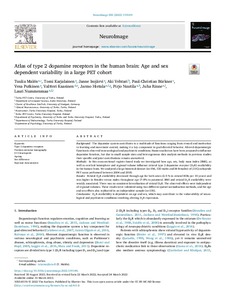Atlas of type 2 dopamine receptors in the human brain: Age and sex dependent variability in a large PET cohort
Malén Tuulia; Karjalainen Tomi; Isojärvi Janne; Vehtari Aki; Bürkner Paul-Christian; Putkinen Vesa; Kaasinen Valtteri; Hietala Jarmo; Nuutila Pirjo; Rinne Juha; Nummenmaa Lauri
https://urn.fi/URN:NBN:fi-fe2022081154843
Tiivistelmä
Background
The dopamine system contributes to a multitude of functions ranging from reward and motivation to learning and movement control, making it a key component in goal-directed behavior. Altered dopaminergic function is observed in neurological and psychiatric conditions. Numerous factors have been proposed to influence dopamine function, but due to small sample sizes and heterogeneous data analysis methods in previous studies their specific and joint contributions remain unresolved.
Methods
In this cross-sectional register-based study we investigated how age, sex, body mass index (BMI), as well as cerebral hemisphere and regional volume influence striatal type 2 dopamine receptor (D2R) availability in the human brain. We analyzed a large historical dataset (n=156, 120 males and 36 females) of [11C]raclopride PET scans performed between 2004 and 2018.
Results
Striatal D2R availability decreased through age for both sexes (2-5 % in striatal ROIs per 10 years) and was higher in females versus males throughout age (7-8% in putamen). BMI and striatal D2R availability were weakly associated. There was no consistent lateralization of striatal D2R. The observed effects were independent of regional volumes. These results were validated using two different spatial normalization methods, and the age and sex effects also replicated in an independent sample (n=135).
Conclusions
D2R availability is dependent on age and sex, which may contribute to the vulnerability of neurological and psychiatric conditions involving altering D2R expression.
-
Kokoelmat
- Rinnakkaistallenteet [27094]
